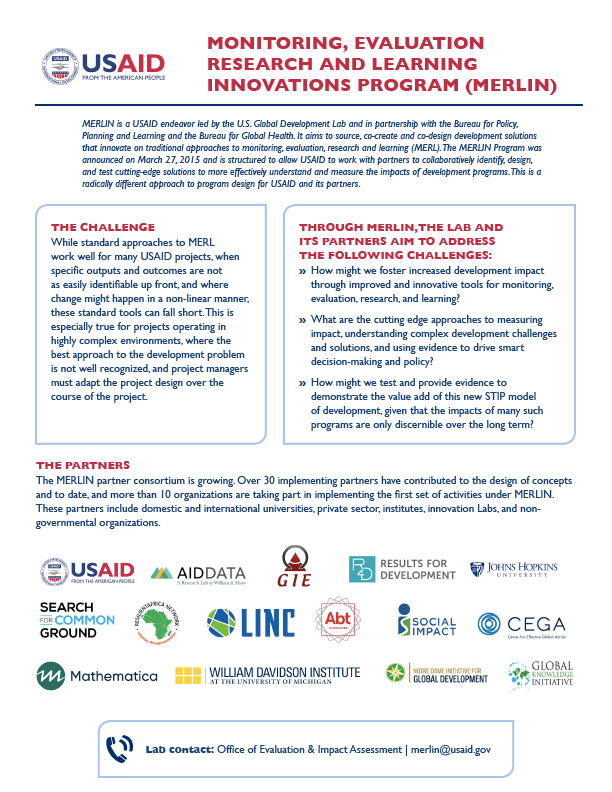- What We Do
- Agriculture and Food Security
- Democracy, Human Rights and Governance
- Economic Growth and Trade
- Education
- Environment and Global Climate Change
- Gender Equality and Women's Empowerment
- Global Health
- Humanitarian Assistance
- Transformation at USAID
- Water and Sanitation
- Working in Crises and Conflict
- U.S. Global Development Lab
Speeches Shim
Monitoring, Evaluation, Research and Learning Innovations Program (MERLIN) is a USAID endeavor led by the U.S. Global Development Lab (the Lab) and in partnership with the Bureau for Policy, Planning and Learning (PPL), and the Bureau for Global Health. MERLIN is a radically different approach to program design for USAID and its partners that allows users to source, co-create, and co-design development solutions that innovate on traditional approaches to monitoring, evaluation, research and learning (MERL).
The MERLIN Program was announced on March 27, 2015 and is structured to allow USAID to work with partners to collaboratively identify, design, and test cutting-edge solutions to more effectively understand and measure the impacts of development programs.
While standard approaches to Monitoring and Evaluation (M&E) work well for many USAID projects, when specific outputs and outcomes are not as easily identifiable up front, and where change might happen in a non-linear manner, these standard tools can fall short. This is especially true for projects operating in highly complex environments, where the best approach to the development problem is not well recognized, and project managers must adapt the project design over the course of the project.
THROUGH MERLIN, THE LAB AND ITS PARTNERS AIM TO ADDRESS THE FOLLOWING CHALLENGES:
- How might we foster increased development impact through improved and innovative tools for monitoring, evaluation, research, and learning?
- What are the cutting edge approaches to measuring impact, understanding complex development challenges and solutions, and using evidence to drive smart decision-making and policy?
- How might we test and provide evidence to demonstrate the value add of this new STIP model of development, given that the impacts of many such programs are only discernible over the long term?
THE PARTNERS
More than 30 partners have contributed to the design of concepts to date, and 17 organizations are taking part in implementing the first set of activities under MERLIN. These partners include domestic and international universities, private sector, institutes, innovation Labs, and non-governmental organizations.
To learn more about individual MERLIN Mechanisms, see the following program descriptions:
MERLIN FAQS
MERLIN Fact Sheet ![]() (pdf - 483k)
(pdf - 483k)
Q: What is MERLIN?
A: The Monitoring, Evaluation, Research, and Learning Innovations Program (MERLIN) is a new initiative led by the Lab and PPL designed to test new and innovative approaches to monitoring, evaluation, research, and learning (MERL). MERLIN is piloting a handful of concepts which, we believe, will have significant potential to deliver improved MERL results. MERLIN was created through a Broad Agency Announcement, which allowed us to co-create the MERLIN mechanisms in collaboration with our external partners.
Q: What is the objective of MERLIN?
A: The standard approach to MERL (established and regularly used within USAID) works well for many USAID projects, especially those with clearly defined theories of change and for which reliable and measurable output and outcome indicators can be identified at the start of the project. For projects in which specific outputs and outcomes are not as easily identified up front, the standard approach to monitoring and evaluation doesn’t always hit the mark. In particular, standard approaches can be overly rigid, do not allow for iteration, and often deliver results too late for key programmatic decisions. The goal of MERLIN is to identify new approaches that overcome these limitations.
Q: How long is the period of performance for the MERLIN mechanisms?
A: For DEPA , SPACES and RAPID FEEDBACK, the period of performance is from October 1, 2015 to September 30, 2024; and for ERIE it is from October 1, 2016 to September 30, 2025.
Contact Us:


Comment
Make a general inquiry or suggest an improvement.